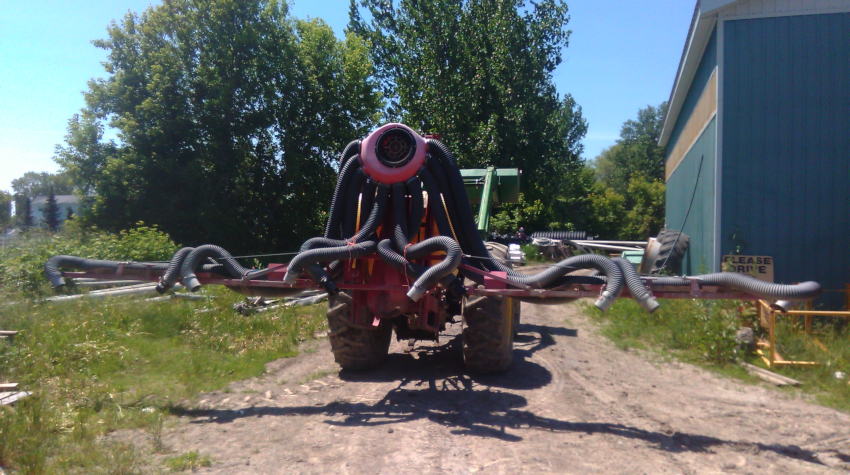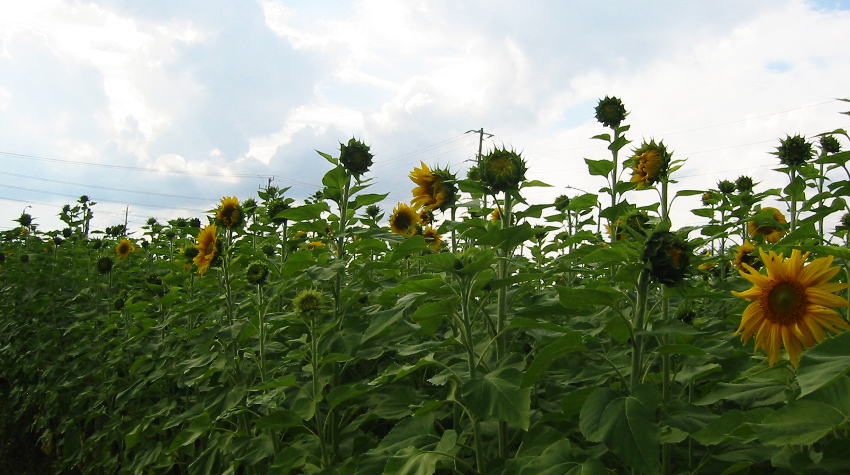Pests and diseases are a part of nature. They can render an entire crop useless. Good planning can significantly reduce the risks, but doing so needs to be an end-to-end solution.
Clipper Weevil. Cyclamen Mites. Aphids. Tarnishing Plant Bugs. Slugs. Anthracnose. Botrytis. Phytopthera. Flea Beetles. Leaf Hoppers. These are just a few pests common on strawberries, and there are many more out there. As much as we want to believe we can grow our food with no pesticides, it's not always practical. After all, growing berries is as much our livelihood as it is our passion. At the end of the day, we still have to make enough profit to put food on the tables for our families. To me, there needs to be a balance point. Somewhere in between where you grow the best berries and aim for the most sustainable means of growing them that doesn't make them overly cost prohibitive to bankrupt yourself. Ultimately, each step we take to reducing our environmental impact makes our strawberries cost more to grow.
It all starts with a plan. Although there are books and documents on how to grow strawberries, thinking outside the box and treating your whole crop as one big cycle is key. A failure to plan is a plan to fail, so to speak.
The first part of our planning is the planting process. Our berry fields are planted on narrow 4' centre rows. Old tractors and machines were all based on old 4' rows, but modern multi-row cropping needed machines with more power so gradually everything moved to 5' rows. We believe in using and keeping old machines going for years and years and we rely on our older, slower, machines to get the job done. Larger rows means a greater leaf canopy. That leaf canopy creates a micro-climate underneath and can invite mould and slugs. The smaller and thinner rows allows for more airflow and less disease pressure.
Every 15 rows of strawberries, we plant two rows of corn. The corn isn't harvested, it acts as a wind-break in the winter to prevent our straw from being blown off and to help catch the snow to insulate the berries for better winter survival. To plant the corn rows, you need a planter from around the 1950's since no modern corn planter is that small. 15 rows also works out to 60', which is a multiple of our older 5-row 20' sprayers. Modern sprayers are at least 50' wide and the tires 5' apart, so again, we're limited ourselves to older technology which is slower and takes more passes.
Cultivation is key to young plants. We need to keep the weeds under control so the new plants can grow. Since a new field is planted every year, that field needs to be kept clean. Modern methods say three weeks after planting, you start herbicide applications to control weeds. But that application is hard on the plant and doesn't make for happy plants. I like happy plants. So we don't do that. Starting 2-3 weeks after planting, we use a couple very old contraptions, our oldest one dating back to 1959 - the Friday Power Hoe: an awkward little device you sit in, steer with your feet, the gear-shifter is out of sight over your head, the brakes are under your armpits, and you drive it looking down and hoe between the berries. For nearly six weeks, we have two people working the Friday Power Hoes to keep our field clean. Our 1959 unit is on it's 3rd engine from being worn out, and our 1989 unit on it's second engine. They both putt away, day-in, day-out to keep our fields clean, our plants stronger, and reduce our herbicide usage.
Speaking of keeping your plants healthy, plants need food. One big advantage of working in a greenhouse is your learn that fertilizer is more than just three number on a package. There are a lot of little subtleties to plant food that change how a plants grows. Beyond the numbers, there's also the unseen beneficial things and symbiotic relationships that happen behind the scenes. Years ago, we began supplementing our field with Mycorrhiza spores to help improve the soil and feed our plants. We've noticed fewer root diseases and stronger plants as a result. We've also begun mixing in a couple new naturally derived fertilizers and foliar feeds. Coupled with the standard N-P-K, there are many micro-nutrients, amino acids, and all kinds of goodies plants like. However, this stuff is liquid and expensive so we need to re-design how and when we add our food since common spreaders won't work with this type of liquid application. The plants love it, though.
When we do have to protect our crop, there's a lot of science involved. First is making sure you don't create a super-bug. Just like in humans when we rely too heavily on antibiotics and get resistant super-bugs, the same can happen in the field. Only it can happen much, much faster since field life-cycles can be short. So when I plan what I'm going to use when, I make sure never to use a product that acts on the pathogen in the same way all the time. By doing that, it ensures a good rotation and responsible farming. We also try and mix bio-pesticides into our mix which are essentially forms of beneficial bacteria and fungi that attack other fungi or insects that harm our plants. I also select modern products with the highest safety ratings. Creating our rotational list is a big job since it goes far beyond just following published recommendations, but takes into account the life cycle of the pathogen, the mode of action of what's being applied, how the weather can increase disease or insect outbreaks to perfect timing, ,and more. Often my "product list" seems long but it's only because I'm doing very specific product rotation and timing to ensure long-term efficacy and safety.
What you apply is one thing, how to apply it equally or more important and it's often overlooked. When it comes to disease and insect control, we turn to our trusty Dr. Octopus. This is, again, a very old and very rare sprayer design for strawberries. It uses a high pressure pump to create a super fine mist and an air turbine to blows the mist right into the canopy of the plant. Getting a perfectly even coverage is key to proper control and there aren't many ways to get reach the bottom of the leaf from the top of the plant without a contraption like this. Because it has been so effective at getting the spray were it needs to be, we've been able to cut our insecticide and fungicide rates by 30%. As an added bonus, the high pressure air has increased pollination rates so we get fewer deformed berries due to poor pollination. But to use this thing, we had to find the narrowest tractor we could with sufficient power to carry and run this thing. Too small and your tractor does wheelies (which is not fun), and too large your crush your berries before you can harvest them. You guessed it, that tractor dates back to the 1970's again since newer ones were too wide. Doing only five rows at a time takes us far longer to go over our field, but the end result is safer for all of us.

It doesn't stop there. After harvest we renovate our fields. We mow off old growth one row at a time, since I haven't found a modern mower that would do as good of a job, and then we thin our rows out. I'm very aggressive at thinning out my berry field. If you recall, we start with 4' centre rows and often the plant canopy is more than half that. When it comes to renovation, I want my plants thinned to around 10"-12" wide. One row at a time we use a heavy rototiller we modified to leave a gap in the middle to very aggressively thin our rows. That leads back to keeping the canopy thin and light to have higher airflow and consequently fewer disease problems.
When we do use herbicides, we do it lightly. Unfortunately, cultivation to keep weeds at bay is only possible until your plants start to take off and run at which point you can't get between the plants any more. Instead of following the book and dropping on full rates, we usually split our applications into multiple very light rates. We make sure to time our applications so the temperature isn't too warm to cause damage and we want it to rain right after application to wash it off the leaves. Worst case scenario, we can turn on our irrigation to wash any residue off the leaves. We aim to use the least amount of herbicides possible to get just enough control. That's why sometimes you do find some weeds in our strawberry fields - we ride the cusp of just enough control rather than lots of herbicides to make everything look perfectly clean. A balance point. After harvest, we go up and down every row one at a time and look for specific hard to control weeds and treat just those spots and not the whole field. Things like Canada Thistle and Tufted Vetch just can't be controlled any other way, but it's better to treat only 1% of the field checking every row than 100% of the field just in case.
As you can see, growing a crop is much more complicated than meets the eye, and putting the added detail in reducing your impact adds significantly to the cost of growing a crop. Cultivating more instead of herbicides cost more money in labour. Using older 20' sprayers take 2-3 times longer to spray the field, which also costs more. Naturally derived fertilizer, Mycorrhiza, and foliar feeds along with their application costs more. Modern lower-impact pesticides in planned rotation costs more. Bio-pesticides cost far more than conventional pesticides. Adding in corn rows reduces the area of a field you can harvest which takes away income. Using smaller machines means doing less with each pass which costs more. Spot-treating row-by-row takes a very long time and costs more. The payoff is a healthier plant, a better tasting berry, and a lower environmental impact. I think it's worth it. Do you?

